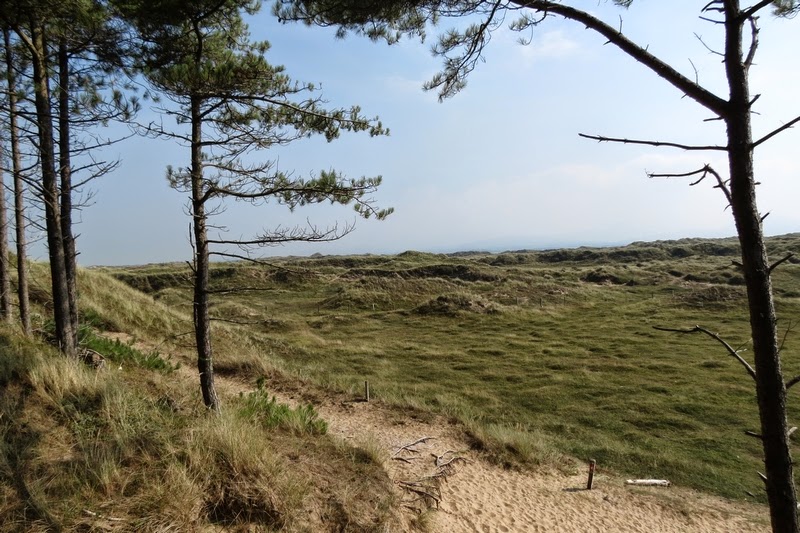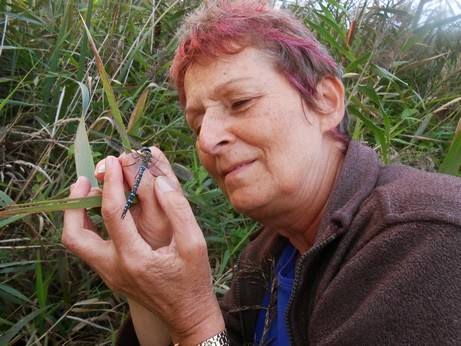 |
| Newborough Warren |
Sometimes I think I’m in a dream, sauntering along on a sunny
day, singing skylarks overhead, the kronking of raven on the headland, chough
chi-owing along cliff faces, even the roar of the overhead jets add to the
sensory delights of stunning Anglesey. Heady thoughts of retiring to a rural
cottage, watching the seasons unfurl, away from the hustle and bustle of cities….mmh
So here we are again ’Another
balmy, sunny day, another place on Anglesey; this time we’re in bunnyland, well
that was what Newborough warren had been
famous for ( as over 100,000 rabbits a year were taken from the warren by the
residents) although on the day we only saw one from the path, I’m sure there
were lots more about, as one of the first things we saw on the sandy path was a
particularly fit looking stoat crossing into the warren, plenty of dinners to be
had here it would seem.
Today’s circular walk starts and ends at the lake of Llyn rhos du
and incorporates a walk through the Corsican and Scots pines of Newborough
forest and a visit to this isle of llanddwyn.
 |
| Sandy paths |
Newborough Warren is part of a National Nature Reserve, which
also includes Llanddwyn Island- the sacred blessed isle of St Dwynwen’s.(Welsh
patron saint of lovers! - Nothing wins hearts
like cheerfulness - St. Dwynwen)
To the left of the
path is the reserve of newborough warren, it’s a massive dune system with a freshwater lake, saltmarsh, mudflats, a
long beautiful beach and stunning views of the sea and Snowdonia
 |
| Lyn rhos du |
Starting at Llyn rhos du’s
car park, a quick look over the freshwater lake from the new bird hide only revealed
coot, little grebe and swooping swallows.
A small herd of white Welsh mountain ponies
were grazing on the warren - used to keep the sward in the condition needed by
the wild plants that grow there. The song of Skylarks,
robin, wren and Meadow Pipits could be heard. A kestrel hovered over the dunes.
The
dunes are also home to toads and lizards, confirmed as a sand
lizard dashed across our path and a young toad narrowly escaped being trodden
on, a case of eyes to the path not to the skies!
The beach at Newborough is long and sandy, and obviously popular
with the locals. Extensive stunning views over to Snowdonia are afforded here. We
continued along the beach to LLanddwyn Island passing some of the oldet rocks
on Anglesey along the way. The island is more a long thin
peninsula that gets cut off from the mainland only on the highest tides- not
marooned today!
 |
| St Dwynwen's cross and lighthouse |
An atmospheric, serene little place,
with its chapel ruins and beacons.
 |
| Chapel ruins |
There are two beacons/lighthouses
built at the tip of the island Tŵr Bach & Tŵr Mawr. The former lighthouse
now returned to service after a modern light was placed on top. Off the tip of the island there were some rocky
outcrops/islands, cormorants and gulls were sunbathing. On an inlet beach, a
party of gulls were squabbling mainly adult and young herring gulls. Two oystercatchers
were on the rocks nearby. Three sandwich terns were careering over the sea
close to shore. As we walked along the island path, smaller residents were
conspicuous, rock pipit and stonechat. A solitary wheatear was popping around
the ruined chapel field.
We stopped for lunch on a promontary, fabulous.
 |
| Newborough view from island |
 |
| Tall Pines |
Leaving St Dwynwen’s resting place behind us we headed back to the
path leading into the forest. This be the home of Red Squirrels, and we were
lucky enough to see one shortly after, scampering up a pine too quickly for my
camera - by the way don't forget to vote for Bob! https://www.voteforbob.co.uk/
 |
| Estuary Afon Cefnii, Malltreath |
There are interpretation boards along the nature reserve path and
trail markers throughout. Good, well-defined paths and the going is generally
easy.
The following day saw us
back in Wales, but this time in Snowdonia. Our aim was to climb the shapely magnificence that is Moel Siabod (2,860 feet) A mountain
that looms large above coniferous forests near to Capel Curig. On a clear day, the summit offers a
fine panorama, revealing part or all of the highest three mountain ranges in
Wales. Unfortunately although the day had dawned warm and windless September’s
mist hung heavy and we could only just make out Snowdon and Tryfan through the
haze as the day waned.
On the route we saw pied
wagtails, buzzard, kestrel, robin, goldfinch, m pipit, skylark, wren and stonechat. As
we approached the summit another highlight two splendid ravens kronked over the
trigpoint, alas gone by the time the weary arrived.
 |
| Bill & laura on the summit |
Anyone considering the walk should
know it can involve a scramble up the ridge dependant on the path
taken to the summit, amazingly didn't seem to stop the sturdy, foot sure sheep...
 |
| Late cuckoo with caterpillar |
One more treat for the day - the path down
the back of the
mountain led us through a dip leading into the forest. A beautiful area,
colourful, rowan trees heavy with berries, grasses thick and swaying and home
to a particularly large black, hairy caterpillar that was about to become lunch
for a cuckoo, a late cuckoo, no doubt taking advantage of the warm September
weather before making it’s long journey to Africa.
 |
| Cuckoo path |
Another fine day out, followed by tea in the Glan Aber , Betws y coed an old haunt of ours,
still serving great pies after twenty years!
Laura





_Jude_Lane_low_res.jpg)





































